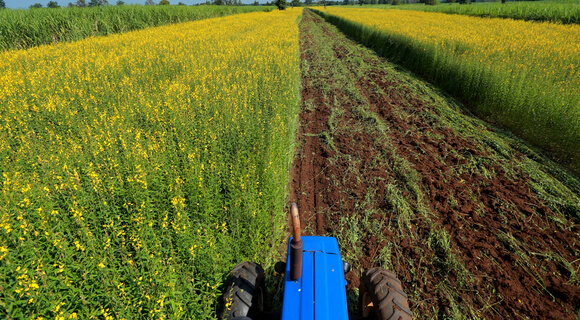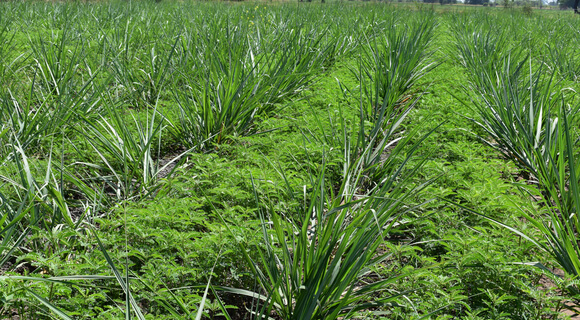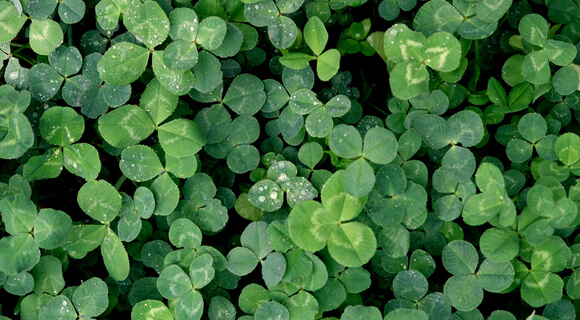No products in the cart.
NEWS
Green Manure Crops: Planting & Management Tips

What Is Green Manure?
Green manure is a specific crop grown with the purpose of being dug into the soil while still green. Such crops are usually planted on unoccupied land between the main crops. While growing, they act as ground cover, preserving the soil structure with their roots system, preventing erosion and the washout of nutrients, suppressing the growth of weeds, and also enriching the soil with nitrogen.
When incorporated into the soil, the plant’s residues decompose and turn into a mass of green manure that can be either dug into the soil or used as mulch – an organic material that covers the soil surface and improves its organic matter.
Green Manure Advantages And Disadvantages
In fact, green manure is among the natural fertilizers that the supporters of organic farming advocate for. The average amounts of nitrogen accumulated by such crops can fully substitute Becker, M., et al. “Green Manure Technology: Potential, Usage, and Limitations. A Case Study for Lowland Rice.” Plant and Soil, vol. 174, no. 1/2, 1995, pp. 181-94. JSTOR. Accessed 28 Dec. 2022. mineral nitrogen fertilizer under the condition of average application rates. Still, there are several challenges one should consider before implementing this approach.

Green Manure Pros
Here are the main reasons to use manuring instead of leaving the ground open.
Soil Protection And Enrichment
Manuring is often performed to shield the main crops from heavy rainfall and strong winds, and enrich the upper and lower soil layers with useful substances. Decomposed plant residues “feed” the soil with organic matter and nitrogen. And while growing, plants saturate the ground with phosphorus, iron, potassium, and calcium Annette Wszelaki. Sarah Broughton. Cover Crops and Green Manures. University of Tennessee Institute of Agriculture.
Soil Erosion And Leaching Prevention
The root system of green manure plants loosens the soil, which ensures a better supply and retention of oxygen and moisture. Besides, the roots perform natural soil tillage, which offers farmers a possibility of growing green manure without tilling the ground. Applying a reduced or no-till farming approach is critical for sustainable agriculture.
When the plant residues decompose, the nutrients they have accumulated are eventually released into the soil, preventing the leaching of these useful substances into the environment.

Weeds Suppression
Green manures effectively hinder weeds development, making it impossible for them to break through the dense biomass to get sunlight, hence performing natural weed management.
Pests And Diseases Prevention
Some crops can repel pests and prevent the development of diseases, decreasing the populations of major pests that threaten the cash crop. Some plants are even capable of trapping pests in their roots.
Beneficial Organisms’ Support
Flowering crops attract pollinating insects, increasing the number of beneficial fauna. For instance, Phacelia’ flowers attract bees and bumblebees.
Besides, manuring benefits soil microbes and other organisms. These organisms and their activities also play a huge part in the creation of soil aggregates, enhancing its porosity and organic matter. The plant roots serve as a source of nutrients for soil microbes. When the plants are dug into the ground, they decompose and facilitate further microbial activity in the soil.

Green Manure Cons
Despite the undeniable benefits, there are some points to consider before using green manure.
Time Needed
Cutting back and rotating cover crops before sowing the main crop is a time-consuming process. It may take up to a month if a crop is allelopathic, meaning it inevitably leaves some toxic substances in the soil, restricting the germination of the successor.
Moisture Usage
Like any other plant, green manure crops also utilize moisture. Hence, if planted in the area with limited moisture levels, they might use up all of the available water. This entails additional irrigation to support the cash crop growth.
Rotation Limits
Manuring means adding another crop to the crop rotation plan, which will also have to be adjusted to ensure it doesn’t exhaust the land. Planting green manure crops right after harvesting the main plant might deprive the soil of the necessary time for rest and rejuvenation.

What Are Some Green Manure Crops?
Depending on the time of sowing, green manures are divided into the following types.
Long-Term Green Manures
Established for two or three years to form a basic part of organic field vegetable and arable rotations. The list of green manure plants for long-term planting includes:
- alfalfa
- perennial ryegrass
- lucerne
- sainfoin
- red clover
- white clover
Winter Green Manures
Sown in fall to be incorporated in the following spring and to act as a fertility building crop by utilizing land that would otherwise be fallow. The best green manure for overwintering includes:
- common vetch or tares
- trefoil
- grazing rye
- mustard
- phacelia
- field beans
- buckwheat
- ryegrass
- tares
Summer Green Manures
Used to provide sufficient nitrogen amid crop rotation. Can be grown either for a whole season from April to September, or just for a period between two main crops. Green manure crops for summer include:
- fenugreek
- mustard
- lupins
- vetch
- buckwheat
- crimson clover
- sweet clover
- persian clover
Undersown Green Manures
The term implies integrating green manure crop into an established cereal crop in spring to enable better weed control. Such crops include:
- lucerne
- yellow trefoil
- oats
- subterranean clover
- red clover
- white clover
Green Manure Mixtures
Term implies sowing several crops simultaneously to magnify the benefits. Among the best green manure crop combinations for mixed planting are:
- red clover/ryegrass
- oats/peas/vetch
- rye/vetch
The mix depends on the types of cultivating cash crops, soil characteristics, and other factors.

When To Sow Green Manure Crops?
In general, planting green manure at any point during a growing season will have its advantages. Although manuring usually serves the purpose of covering the ground in fall and winter due to its ability to prevent erosion, it also offers similar benefits in the summer months, providing protection against the drying effects of wind and sun.
When To Dig In Green Manure Crops?
The best time for digging in the plants is two or three weeks prior to using the soil again, or when they are reaching maturity stage. The young plants’ mass will decompose fast enough to “feed” the soil. That is why it’s critical not to wait until flowering. Besides, consider digging in before the stems become woody and harder to break down in the soil.
To determine the best time for digging in green manure, you can use software tools like EOSDA Crop Monitoring. The platform is of help throughout the whole cultivation span, be it the cash crops or manures. All you have to do is enter the data on crop name, sowing date, and maturity.

Now you can easily track stages of plant growth to decide on when to dig it in for getting the maximum benefit. Find the time before the plants start flowering, and especially before they go to seed or before the stems become woody and hard to break down into the ground.
How Does Green Manure Impact the Soil?
Green manures return nutrients to the soil, protect the soil from water and wind erosion, and also prevent overheating of the top layer of arable land by solar irradiation.
Does green manure add nutrients to soil? Yes, it provides the land with all the necessary elements. Decomposed plants’ mass enriches the soil with macro- and microelements (including nitrogen, phosphorus, and potassium), which are essential for healthy crop growth.
In case growing a green manure crop is not enough to cover the soil needs for fertilizers, additional application is required. Use EOSDA Crop Monitoring Zoning feature to apply the VRA approach to soil fertilization, avoiding overapplication and pollution of soil and water, while saving time and money.

Green Manure For Clay Soil
It’s critical to choose the type of crop depending on the soil. For instance, the best green manure for clay soil would be:
- alfalfa
- winter wheat
- fenugreek
- buckwheat
- clover
- lupins
- cowpea
These plants have deep roots, which allows them to pull nutrients from the subsoil to the top, while breaking up the compact clay. Plant them in fall and dig them into the soil in spring before they go to seed.
Green Manure For Sandy Soils
The best green manure crops for sandy soils would be those capable of enhancing the land’s water retention ability and nutrients content. These include:
- oats
- buckwheat
- millet
Green Manure As A Sustainable Agricultural Practice
Integrating green manures into crop rotation allows for maintaining soil fertility according to the key principles of sustainable agriculture. Offering numerous benefits, green manure enables soil protection, fertilization, and its organic content improvement, which is critical for eliminating the threat of land degradation. And more healthy soils means more sustainable food production due to fewer chemicals’ application needed and less tillage required.
The possibility of using less synthetic fertilizers and heavy machinery throughout crop cultivation implies a significant reduction in air and water pollution rates. Hence, growing green manure crops enables growers to build an organic farm.
References
- Becker, M., et al. “Green Manure Technology: Potential, Usage, and Limitations. A Case Study for Lowland Rice.” Plant and Soil, vol. 174, no. 1/2, 1995, pp. 181-94. JSTOR. Accessed 28 Dec. 2022.↑Journal article
- Annette Wszelaki. Sarah Broughton. Cover Crops and Green Manures. University of Tennessee Institute of Agriculture↑Online source



